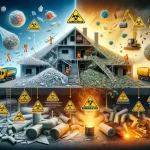Electronic garbage, or “e-waste,” is a growing environmental problem that has put us at a crossroads in our continuous quest for technological growth. Not only does the constant stream of antiquated devices, from ubiquitous cellphones to essential computers, portend a period of technological advancement, but it also signals a period of environmental and health emergencies. This talk explores the maze of e-waste, explains its implications, and highlights innovative, environmentally responsible methods for managing it effectively.
Unraveling the Mystery of E-Waste
E-waste is the term for a large quantity of abandoned electronic devices that have outlived their use or appeal. Electronics become outdated quickly due to the rapid advancement of technology, making e-waste one of the waste categories with the fastest worldwide growth. This unrelenting build-up not only wastes priceless resources but also poisons ecosystems with pollutants like lead, mercury, and cadmium.
The Effects of E-Waste on Human Health and the Environment
The improper management of electronic waste presents serious risks, as it permits harmful substances to enter the land and water, endangering both human health and the natural balance of the ecosystem. The informal recycling of e-waste, which is typified by unregulated burning and dismantling, increases the danger of hazardous exposure and causes serious health problems for the local people, especially in less developed areas.
Mapping the Path for the Reduction of E-Waste
A comprehensive plan that balances technology innovation, policy innovation, and public awareness is required to mitigate the e-waste challenge. The following are essential paths for long-term e-waste management:
- Longevity of Augmenting Device
Keeping electronics in service for longer is a powerful way to combat the e-waste epidemic. The design of robust, repairable goods and ongoing software support may help accomplish this. Customers are also urged to prioritize maintenance and repairs over complete replacements, which promotes a culture of longevity.
- Promoting Resource Recovery and Recycling
Initiatives for recycling and resource recovery are essential to e-waste management because they make it possible to recover valuable materials from obsolete gadgets for later use. The development of efficient recycling processes and infrastructures is essential to reducing the environmental impact of electronic waste and preserving natural resources. To support recycling initiatives and ensure the appropriate processing of e-waste, government agencies, and the commercial sector must work together.
- Putting in Place Regulatory Frameworks for E-Waste
Enacting strong e-waste laws may encourage proper recycling and disposal methods, resulting in e-waste management that is ecologically responsible. Laws requiring manufacturers to take responsibility for the end-of-life disposal of their goods might encourage the incorporation of recycling programs and green design concepts.
- Promoting Awareness of E-Waste
It is essential to raise awareness about the effects that e-waste has on the environment and the need to dispose of it responsibly. Education campaigns may help reduce e-waste by giving customers the information they need to make wise decisions about the purchase, disposal, and recycling of gadgets.
Looking Toward the Future
The problem of e-waste highlights the urgent need to change digital consumption and manufacturing patterns to more sustainable ones. Through supporting innovative solutions, advocating for strict regulations, and fostering a communal awareness of e-waste, we can mitigate its harmful effects on the environment and human health. The road to sustainable e-waste management is long and difficult, but it is necessary to protect our natural heritage and create a stronger, healthier world for future generations.








